‘The indiscreetest and wildest creature that ever was in a Court’
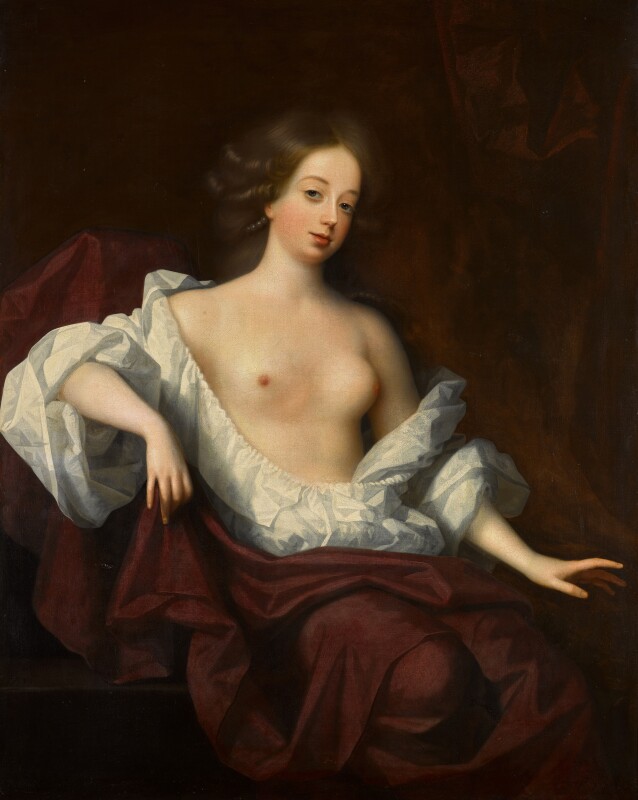
Described by biographers as ‘the real Queen of Restoration England’, few Royal Mistresses can claim greater fame than Nell Gwyn.1 Actress, muse, patroness and official mistress to King Charles II for a period of seventeen years, Gwyn’s life might be England’s greatest rags to riches story. Charles Beauclerk (b. 1965), heir to the present Duke of St Albans and a descendent of Nell, went as far to describe his forebear as ‘the original people’s princess […] [whose relationship with Charles II] symbolizes the union of sovereign and his people.’2 Contemporaries described her as ‘the indiscreetest and wildest creature that ever was in a Court’, a figure who epitomized the spirit of the age.3 The present work, showing Nell décolletée, with an open bodice, is one of the few portraits that has been securely identified as Charles’s most famous mistress. Such paintings attest to Nell Gwyn’s fame as a pioneer of celebrity in Britain.4

Virtually nothing is known of Gwyn’s upbringing, despite the fact that her date of birth is recorded on a horoscope in the Bodleian Library as 2 February 1650 (ODNB). It is generally considered that Nell was brought up in London to a low born family, whose income she supplemented by working as an orange seller in Covent Garden during her youth. Her natural talents and wit defied the harrowing expectations that this precarious position offered. It was at the age of fourteen in 1664 when her fortunes blossomed with a successful career as an actress performing at the Theatre Royal. The celebrity of the stage propelled her into the sight of admiring crowds and affluent noblemen, attention which she relished. Charles Sackville, Lord Buckhurst and later 6th Earl of Dorset, (1643–1706) was described by Pepys as the first to have made ‘pretty, witty Nelly’ his kept mistress for a short period at a house in Epsom, Surrey.5 As revisionist historians writing on the history of prostitution in London have highlighted, becoming an elite courtesan or mistress was the only way which a low-born girl of the period could ‘raise herself from the chamber pot of society’.6 It also ensured a more privileged education than low birth afforded and allowed for a form of unprecedented financial independence which allowed women to take care of themselves and their families. Nell’s success as mistress and courtesan is perhaps the greatest shining example of this, in contrast to the lesser fortunes of many women of the same period.
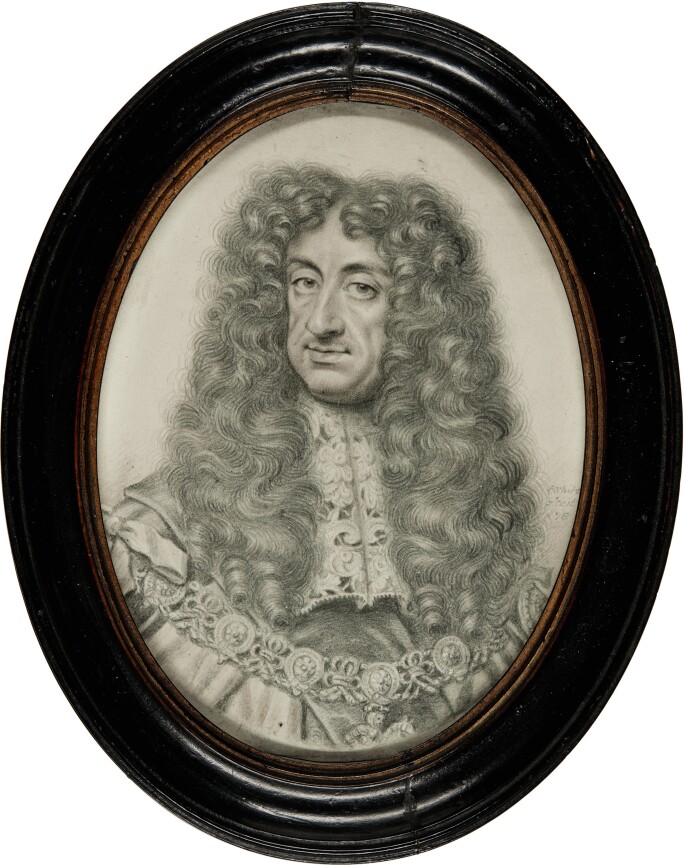
The power of Nell’s physical beauty eventually won the admiration of the King himself. By 1669 Charles had made her his mistress and by 1671 had removed her from the stage and into a fine house on Pall Mall next to St James’s Palace. Nell was an officially recognized Royal mistress for seventeen years, a privileged position that provided an income of £4000 per year, which eventually increased to £5000 by 1676. This love affair resulted in two children. Their sons Charles (1670–1726) and James (1671–1680), who were eventually bestowed the titles of Duke of St Alban’s and Lord Beauclaire respectively, ensured the longevity of Nell’s tenure until her death in 1687.
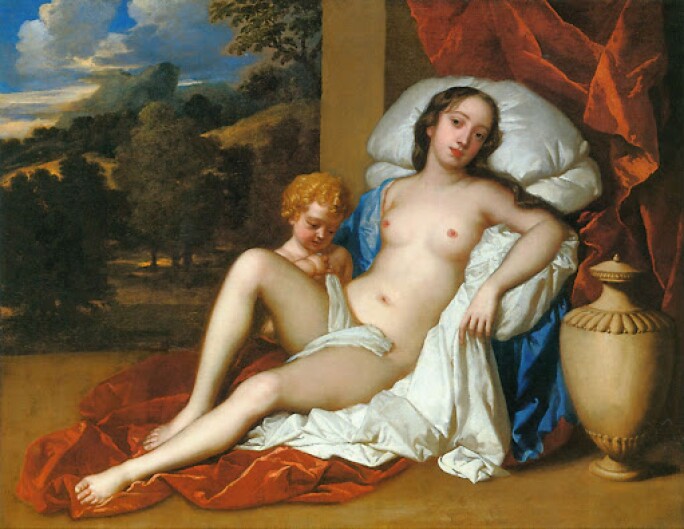
Nell’s success as mistress is most evident in her marked influence and survival at Charles II’s court. Her position was not diminished even in light of competition from the likes of Charles’s Catholic mistress Louise de Kérouaille, Duchess of Portsmouth (1649–1734). It was the fierce rivalry with Louise that resulted in Nell purportedly declaring in public that she was in-fact ‘The Protestant Whore’, in contrast to her French-born Papist opponent.7 Unlike the other mistresses of Charles, Nell was from the lowest stock and played this to her advantage in cultivating a particularly earthy cult of personality around herself. Her part in political intrigue, heightened during various political allegiances and catastrophes such as the succession crisis, demonstrates how far mistresses could exert their influence. Famously, Charles's deathbed request to his brother, the future James II, is said to have been ‘Let not poor Nelly starve’.
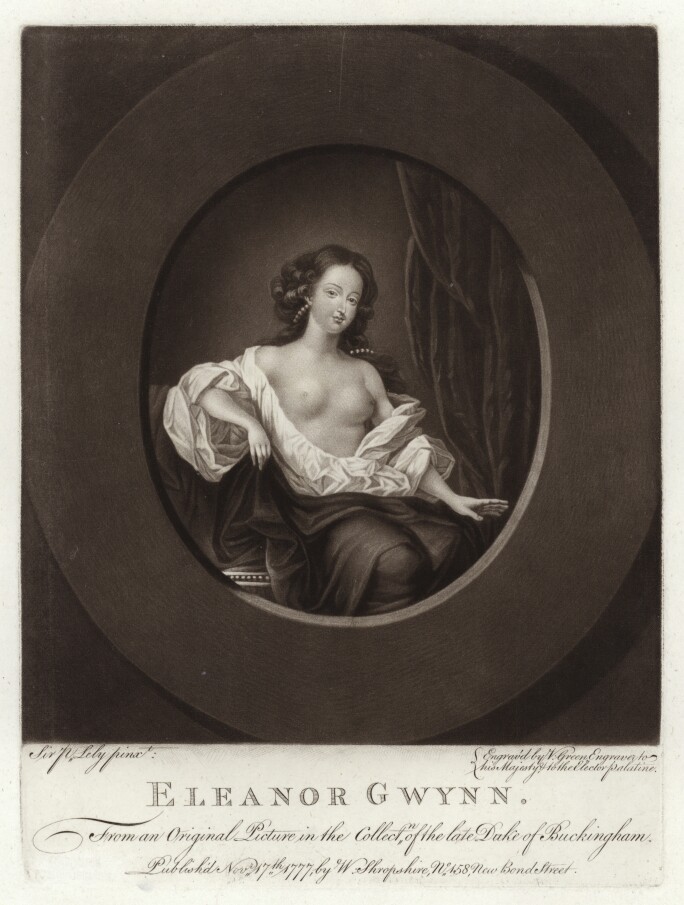
This is one of very few portraits to be confidently and convincingly identified as Nell Gwyn.8 Her identity is confirmed by the early engraving of her made by Valentine Green less than one hundred years after her death (Fig. 1). The production of portraits, which were often turned into popular prints, was a form of celebrity which Nell seems to have actively encouraged. Dated to c. 1680–85, the artwork was painted by the Hague-born Simon Pietersz Verelst (1644–c. 1710) and bears the remains of his signature in the lower center of the canvas. Verelst began his career as a successful flower painter, whose work in the still-life genre Pepys once described as ‘the finest thing that ever, I think, I saw in my life’.9 The artist eventually came to London in 1669 where he branched into other genres of art. The antiquary George Vertue recorded in his notebooks that it was George Villiers, 2nd Duke of Buckingham (1628–1687) who encouraged the Dutchman to be a ‘face-painter’.10 The Duke of Buckingham’s patronage of Verelst is of particular interest to the painting in question. Firstly, Buckingham was known as a confidant and patron to Gwyn, starting from Nell’s theatre days and culminating in her political and friendly allegiance with him during the 1670s and ’80s.11 Secondly, this particular portrait was recorded as being in the collections of the Dukes of Buckingham when it was engraved by Valentine Green in 1777.12 The minute corresponding details found in the print, particularly the arrangement of the hair and pearls, makes a highly compelling case for this being the original picture which Green had used for the basis of his engraving.
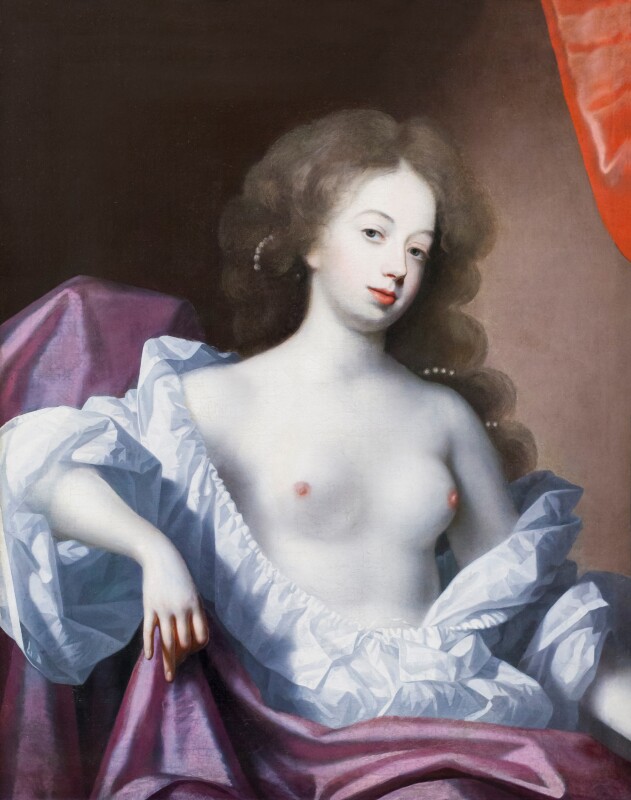
Verelst painted Gwyn using at least two facial types.13 The current painting is one of only two that follows the same facial pattern and compositional format. The other is a simplified and reduced version preserved in a private collection and is currently on loan to the National Portrait Gallery in London (Fig. 2).14 A close comparison shows that the present version contains a more complex set of details, particularly in the hair and drapery in the background.15
The highly sensual subject manner and rendering, showing Nell with her breasts exposed above her lowered bodice, is undoubtedly influenced by Venetian precedents of the sixteenth century. Titian’s Venuses, showing reclining nude figures staring engagingly at the intended viewer, are clearly the source of such an enticing and decadent image. This may have been a pose and format that Gwyn actively preferred. The decidedly daring appearance is found in all the other versions of Nell by Verelst, including a bust-length portrait preserved in the National Portrait Gallery, London. Furthermore, Nell – bare-chested – was captured in another lost portrait, depicting her with her two sons as cherubs, whose surviving engraving ascribes it to the French artist Henri Gascar (1635–1701).16
Although such brazen eroticism and nudity is most often associated with the decadence of the Restoration Court, this was not the first bawdy portrait of a mistress in Stuart Britain. Famously, King Charles I had owned Van Dyck’s partially nude portrait of his painter’s mistress, Margaret Lemon.17 Although Lemon’s portrait recalls Venetian precedents, Gwyn’s is liberated from iconographical baggage in favour of a direct and sensuous eroticism.
Verelst’s stylistic traits are evident throughout the canvas, particularly in the richly coloured drapery contrasted against the pale silverly flesh of the sitter. The supremely delicate and soft modulations of colour in the flesh tones gives the image a particularly soft focus and ethereal air. Contrasts of deeply saturated reds and white, or a rich purple and plum red in this case, is also found in the aforementioned works by Verelst.18
This image may have had an afterlife that stretched into the next century of British Art. It is possible that William Hogarth knew of the portrait when he painted and later engraved his famous set The Harlot's Progress. The scandalously open bodice and direct pose is highly reminiscent of Hogarth’s Moll Hackabout, found in plate 3 of that famous series. Moll, an elite courtesan who falls on hardship, may have been envisioned as a moralizing inversion of Nell’s staggering success in that role.
1 R. MacGregor-Hastie, Nell Gwyn, London 1987, p. 12.
2 C. Beauclerk, Nell Gwyn: a Biography, London 2005, p. 1.
3 This quote from Bishop Gilbert Burnet (1643–1715) is transcribed in A. Hamilton (ed), Memoirs of the Court of King Charles II, London 1891, p. 408.
4 G. Perry, J. Roach and S. West (eds), The First Actresses: Nell Gwyn to Sarah Siddons, exh. cat., London 2011, p. 64.
5 H.B. Wheatley, The Diary of Samuel Pepys M.A. F.R.S., vol. VIII, London 1896, p. 20.
6 H. Rubenhold, The Covent Garden Ladies: Pimp General Jack and the Extraordinary Story of the Harris’s List, Stroud 2006, pp. 50 and 52–53.
7 For a discussion on the history and political dimensions of this see A. Conway, The Protestant Whore: Courtesan Narrative and Religious Controversy in England, 1680–1750, Toronto, Buffalo and London 2010, pp. 17–49.
8 The often confused and erroneous identification of Nell in late seventeenth-century portraiture was expressed by David Piper in his Catalogue of the Seventeenth-Century, Portraits in the National Portrait Gallery, 1625–1714, Cambridge 1963, p. 149.
9 H.B. Wheatley, The Diary of Samuel Pepys M.A. F.R.S., vol. IX, London 1896, p. 289.
10 G. Vertue, ‘Notebooks’ in The Walpole Society, vol. XVIII, 1930, p. 32, [V. 14, B.M. 12b].
11 J.H. Wilson, Nell Gwyn: Royal Mistress, New York 1952, pp. 84–89, 175–77, 202–4.
12 Green’s print bears the inscription ‘From an Original Picture in the Collectn of the late Duke of Buckingham/ Published in Nov 17th 1777, by W. Shropshire, No. 458, New Bond Street.’ The painting is erroneously given to Sir Peter Lely in Green’s print.
13 Known portraits of Nell Gwyn by Verelst are listed in Macleod and Alexander 2001, pp. 170–71. The other face type encountered is found in three surviving paintings. The primary source is a bust-length portrait in the National Portrait Gallery, London; another showing Gwyn in the guise of Diana the Huntress was sold anonymously, Sotheby’s, London, 16 May 1990, lot 19; and the final was sold at the Littlecote House Sale, Sotheby’s, 20 November 1985, lot 857 and was later with Philip Mould & Co. by 2015.
14 This painting, on loan to the National Portrait Gallery since 2012, was recorded in the collection of Arnold Wiggins in October 1949 (according to a photograph in the Heinz Library).
15 The same compositional format was employed in another painting by Verelst, An Unknown Lady holding grapes, sold anonymously, Christie’s, London, 24 February 1995, lot 34.
16 G. Perry, J. Roach and S. West (eds), The First Actresses: Nell Gwyn to Sarah Siddons, exh. cat., London 2011, pp. 68–69, fig. 40 reproduced.
17 O. Millar in Van Dyck: A Complete Catalogue of Paintings, S.J. Barnes, N. De Poorter, O. Millar and H. Vey (eds), Newhaven and London 2004, p. 552, no. IV.157, reproduced.
18 See n. 13.